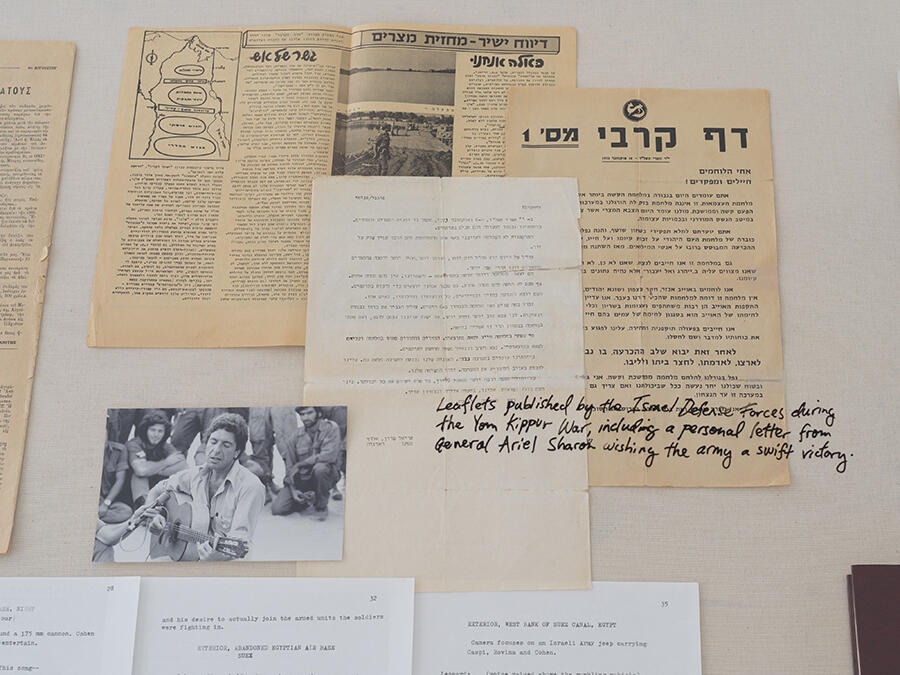Michael Rakowitz’s Fading Fandom
At Barbara Wien, Berlin, the artist reevaluates his love of Leonard Cohen in light of the musician’s stance on Palestine
At Barbara Wien, Berlin, the artist reevaluates his love of Leonard Cohen in light of the musician’s stance on Palestine

Be it a god, an idol or an ideology, we all worship something, seeking out frameworks of meaning to help us identify our values and find our place in the world. The subject of Michael Rakowitz’s reverence is none other than singer-songwriter Leonard Cohen, who is the focus of his exhibition at Barbara Wien, ‘I’m good at love, I’m good at hate, it’s in between I freeze’.

The titular installation comprises a 32-minute video alongside vitrines filled with records, newspaper clippings, books, photographs, an olive branch from Cohen’s house on Hydra, bedrock from his childhood home and an Olivetti Lettera 22 typewriter, which Rakowitz bought to write a letter to Cohen. Don’t be deceived if this sounds like fandom: the work delves into Cohen’s relationship, as a prominent Canadian Jew, to the Israeli–Palestinian conflict and Rakowitz’s attempt to understand whether we can separate an artist from their music, and what it means to let go of the belief in something or someone without losing ourselves.

Rakowitz’s video focuses on a concert Cohen was supposed to play at the Ramallah Cultural Palace in 2009, but which was boycotted and subsequently cancelled due to his historical stance on the region’s geopolitics, which many believe rendered this gesture an empty offering. A Cohen lookalike is depicted wandering the streets of Ramallah, peering into closed buildings and sitting contemplatively at his typewriter, sunlight illuminating his face. The introspective and somewhat overly sentimental footage is filtered with a sun-bleached grade, seemingly mediating an intimate, untold history.

In a voice-over, Rakowitz reads his letter to Cohen, in which he cites a 1973 photograph of the singer standing next to Israeli general and future Prime Minister, Ariel Sharon. Accompanied by a guitarist, Cohen is entertaining troops on the battlefield of the Yom Kippur War, fought between Israel and a coalition of Arab states led by Egypt and Syria. Rakowitz also discusses Cohen’s diaries, in which he talks about the war as posing an existential threat to Jewish people and the relief he felt upon learning that the body bags being taken across the Suez Canal contained Egyptians. In the video, Cohen’s views are suggested in a poignant scene of a bath, in which two scooped out watermelons – a symbol of Palestinian resistance, its colours mirroring the Palestinian flag – become boats harbouring little figurines of Cohen and Umm Kulthum (whose songs inspired Egyptian and Syrian soldiers), slowly bobbing past one another.

As a person of Arabic-Jewish heritage, Rakowitz often combines the personal and the political in his art, interweaving autobiography with reflections on human-rights abuses. Seeing Cohen’s story as an articulation of the ethical crisis of the post-holocaust Jew – as he says in the video, a Zionist position he is personally unable to support ‘because of what it forgets’: namely, the occupation of Palestinian territories and the displacement of its people – Rakowitz sought permission from the singer’s estate to stage the concert that never happened, his lungs a vessel to complete the story.

Ultimately, his request was denied along with any rights to play Cohen’s music. The video closes with Rakowitz strumming and singing into the darkness of an empty spot-lit theatre. Yet, instead of music, we hear a reading from Edward Said’s After the Last Sky (1986), a portrait of Palestinian life and identity. In looking for a way to let Cohen’s original gesture survive, Rakowitz ultimately effects a double erasure: the denial of Cohen’s solidarity with the Palestinian people and the rejection of his own love for Cohen. The power of this work lies in Rakowitz’s concluding grief, the visceral emotion underpinning his acceptance that neither artists nor institutions are neutral and that, sometimes, the imagined potential of our idols just doesn’t play out.
Michael Rakowitz’s ‘I’m good at love, I’m good at hate, it’s in between I freeze’ is on view at Barbara Wien, Berlin, until 12 August
Main image: Michael Rakowitz, I’m good at love, I’m good at hate, it’s in between I freeze, 2017/2023, film still. Courtesy: the artist and Galerie Barbara Wien, Berlin























